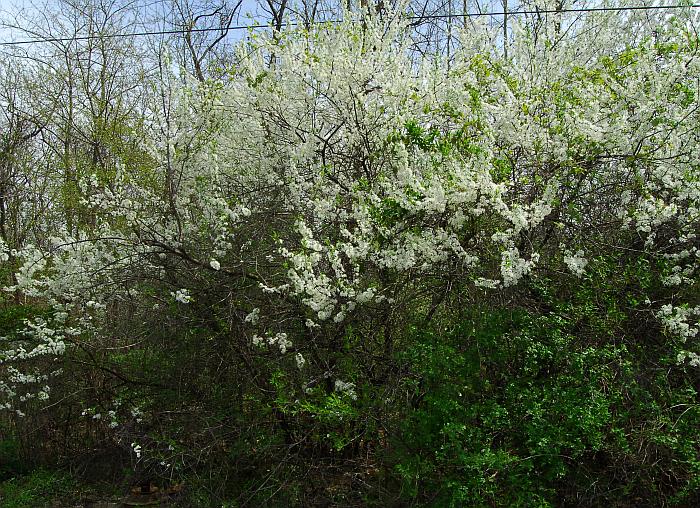Prunus hortulana L.H. Bailey
Wild Goose Plum

Native
CC = 3
CW = 5
MOC = 49
© SRTurner
Prunus hortulana L.H. BaileyWild Goose Plum | |
 |
Native CC = 3 CW = 5 MOC = 49 |
© SRTurner |
|
Family - Rosaceae Habit - Shrub to 5 m tall, or small tree to 6 m tall, sometimes suckering to form thickets. Stem - Bark dark reddish brown to dark gray, on younger trunks relatively smooth and sometimes somewhat shiny, but with prominent, raised branch scars and light-colored lenticels in transverse lines, on older trunks usually developing more or less rectangular, fine, scaly plates, these sometimes peeling. Twigs glabrous, producing pseudoterminal winter buds, these usually in a cluster of 2 or 3 at the tip.
Inflorescences - Produced when the leaves are about half grown, umbellate clusters of 2-4 flowers per bud, the flower stalks 8-20 mm long, glabrous.
Flowers - Flowers with the hypanthium 2-3 mm long, bell-shaped, glabrous. Sepals 1.5-3.0 mm long, ascending to reflexed at flowering, ovate, the margins with dark glandular teeth, the inner surface densely short-hairy below the midpoint. Petals 4-9 mm long, obovate, white. Flowers fragrant.
Fruits - Pomes 20-30 mm long, globose, shallowly longitudinally grooved on 1 side, the surface red to yellowish, with conspicuous white dots, glabrous, not or only slightly glaucous, the fleshy layer well-developed, the stone ovoid-ellipsoid, somewhat flattened, the surface shallowly pitted. Flowering - March - May. Habitat - Streambanks, pond margins, prairies, fields, pastures, fencerows, old homesites, railroads, and roadsides; also cultivated. Origin - Native to the U.S. Lookalikes - Other members of the genus, especially P. americana and P. mexicana. Other info. - This species is found across most of Missouri. Its U.S. distribution is limited, with Missouri and Illinois forming the densest nucleus of its range. In appearance it is similar to other species of Prunus, with one differentiating character being the presence of dark glands along the sepal margins. These can be clearly seen in the second calyx image above, and are also readily discerned in the field with the aid of a magnifying loupe. The inside surfaces of the sepals are also densely hairy at the base. The flowers, like those of most members of the genus, are pleasantly fragrant. Photographs taken near Labadie, Franklin County, MO, 4-13-2019 (SRTurner). |